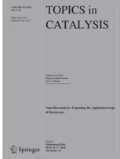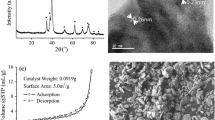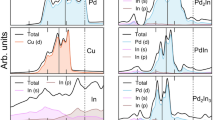Abstract
Herein, we have shown that the phase composition of molybdenum carbide catalysts has a pronounced effect on the pairwise hydrogen addition selectivity in the gas-phase propyne hydrogenation with parahydrogen. Molybdenum carbide catalysts were prepared using either the Pechini method or temperature-programmed reduction with CH4/H2 carburizing gas mixture. The structures of carbide catalysts were characterized by high-resolution transmission electron microscopy, X-ray diffraction, and X-ray photoelectron spectroscopy. It was found that molybdenum carbide prepared by the Pechini method predominantly contains a face-centered-cubic MoC1−x phase, while the TPR method yields a hexagonal-close-packed Mo2C phase. By varying the gas hourly space velocity of carburizing gas mixture, the defected phase can be produced. Computer modeling for XRD patterns was used to identify the phase composition of Mo2C catalysts. All the catalysts were found to be active in pairwise hydrogen addition; however the hcp-Mo2C phase exhibits a higher contribution of pairwise H2 addition providing ~ 150-fold proton NMR signal enhancement.






Similar content being viewed by others
References
Hövener J-B, Pravdivtsev AN, Kidd B et al (2018) Parahydrogen-based hyperpolarization for biomedicine. Angew Chem Int Ed 57:11140–11162
Bowers CR, Weitekamp DP (1986) Transformation of symmetrization order to nuclear-spin magnetization by chemical reaction and nuclear magnetic resonance. Phys Rev Lett 57:2645–2648
Natterer J, Bargon J (1997) Parahydrogen induced polarization. Prog Nucl Magn Reson Spectrosc 31:293–315
Green RA, Adams RW, Duckett SB et al (2012) The theory and practice of hyperpolarization in magnetic resonance using parahydrogen. Prog Nucl Magn Reson Spectrosc 67:1–48
Oldham SM, Houlis JF, Sleigh CJ et al (2000) Observation of new intermediates in the reaction of dihydrogen with iridium, rhodium, and mixed metal A-frame complexes with parahydrogen-induced polarization. Organometallics 19:2985–2993
Schott D, Callaghan P, Dunne J et al (2004) The reaction of M(CO)3(Ph2PCH2CH2PPh2) (M = Fe, Ru) with parahydrogen: probing the electronic structure of reaction intermediates and the internal rearrangement mechanism for the dihydride products. Dalt Trans 3:3218–3224
Hübler P, Giernoth R, Kümmerle G, Bargon J (1999) Investigating the kinetics of homogeneous hydrogenation reactions using phip nmr spectroscopy. J Am Chem Soc 121:5311–5318
Buljubasich L, Franzoni MB, Münnemann K (2013) Parahydrogen induced polarization by homogeneous catalysis: theory and applications. In: Kuhn L (ed) Hyperpolarization methods in NMR spectroscopy. Topics in current chemistry. Springer, Berlin, pp 33–74
Kovtunov KV, Zhivonitko VV, Skovpin IV et al (2013) Parahydrogen-induced polarization in heterogeneous catalytic processes. In: Kuhn LT (ed) Hyperpolarization methods in NMR spectroscopy. Springer, Berlin, pp 123–180
McCormick J, Korchak S, Mamone S et al (2018) More than 12% polarization and 20 minute lifetime of 15N in a choline derivative utilizing parahydrogen and a rhodium nanocatalyst in water. Angew Chem Int Ed 57:10692–10696
Salnikov OG, Kovtunov KV, Koptyug IV (2015) Production of catalyst-free hyperpolarised ethanol aqueous solution via heterogeneous hydrogenation with parahydrogen. Sci Rep 5:13930–13936
Kovtunov KV, Barskiy DA, Shchepin RV et al (2016) Production of pure aqueous 13C-hyperpolarized acetate by heterogeneous parahydrogen-induced polarization. Chemistry 22:16446–16449
Glöggler S, Grunfeld AM, Ertas YN et al (2015) A nanoparticle catalyst for heterogeneous phase para-hydrogen-induced polarization in water. Angew Chem Int Ed 54:2452–2456
Glöggler S, Grunfeld AM, Ertas YN et al (2016) Surface ligand-directed pair-wise hydrogenation for heterogeneous phase hyperpolarization. Chem Commun 52:605–608
Bales LB, Kovtunov KV, Barskiy DA et al (2017) Aqueous, heterogeneous para-hydrogen-induced15N polarization. J Phys Chem C 121:15304–15309
McCormick J, Grunfeld AM, Ertas YN et al (2017) Aqueous ligand-stabilized palladium nanoparticle catalysts for parahydrogen-induced 13C hyperpolarization. Anal Chem 89:7190–7194
Kovtunov KV, Barskiy DA, Coffey AM et al (2014) High-resolution 3d proton MRI of hyperpolarized gas enabled by parahydrogen and Rh/TiO2 heterogeneous catalyst. Chemistry 20:11636–11639
Kovtunov KV, Truong ML, Barskiy DA et al (2014) Propane-d6 heterogeneously hyperpolarized by parahydrogen. J Phys Chem C 118:28234–28243
Burueva DB, Kovtunov KV, Bukhtiyarov AV et al (2018) Selective single-site Pd-In hydrogenation catalyst for production of enhanced magnetic resonance signals using parahydrogen. Chemistry 24:2547–2553
Zhou R, Cheng W, Neal LM et al (2015) Parahydrogen enhanced NMR reveals correlations in selective hydrogenation of triple bonds over supported Pt catalyst. Phys Chem Chem Phys 17:26121–26129
Wang W, Xu J, Zhao Y et al (2017) Facet dependent pairwise addition of hydrogen over Pd nanocrystal catalysts revealed via NMR using para-hydrogen-induced polarization. Phys Chem Chem Phys 19:9349–9353
Salnikov OG, Burueva DB, Gerasimov EY et al (2015) The effect of oxidative and reductive treatments of titania-supported metal catalysts on the pairwise hydrogen addition to unsaturated hydrocarbons. Catal Today 283:82–88
Zhao EW, Zheng H, Ludden K et al (2016) Strong metal–support interactions enhance the pairwise selectivity of parahydrogen addition over Ir/TiO2. ACS Catal 6:974–978
Oyama ST (1992) Preparation and catalytic properties of transition metal carbides and nitrides. Catal Today 15:179–200
Porosoff MD, Yang X, Boscoboinik JA, Chen JG (2014) Molybdenum carbide as alternative catalysts to precious metals for highly selective reduction of CO2 to CO. Angew Chem Int Ed 126:6823–6827
Ramanathan S, Oyama ST (1995) New catalysts for hydroprocessing: transition metal carbides and nitrides. J Phys Chem 99:16365–16372
Volpe L, Boudart M (1985) Compounds of Molybdenum and tungsten with high specific surface-area I. Nitrides. J Solid State Chem 59:332–347
Volpe L, Boudart M (1985) Compounds of molybdenum and tungsten with high specific surface area II. Carbides. J Solid State Chem 59:348–356
Chaudhury S, Mukerjee SK, Vaidya VN, Venugopal V (1997) Kinetics and mechanism of carbothermic reduction of MoO3 to Mo2C. J Alloys Compd 261:105–113
Smirnov AA, Geng Z, Khromova SA et al (2017) Nickel molybdenum carbides: synthesis, characterization, and catalytic activity in hydrodeoxygenation of anisole and ethyl caprate. J Catal 354:61–77
Stux AM, Laberty-Robert C, Swider-Lyons KE (2008) Pechini synthesis and characterization of molybdenum carbide and nickel molybdenum carbide. J Solid State Chem 181:2741–2747
Segal D (1997) Chemical synthesis of advanced ceramic materials. J Mater Chem 7:1297–1305
Vojvodic A (2012) Steam reforming on transition-metal carbides from density-functional theory. Catal Lett 142:728–735
Wan C, Regmi YN, Leonard BM (2014) Multiple phases of molybdenum carbide as electrocatalysts for the hydrogen evolution reaction. Angew Chem Int Ed 53:6407–6410
Posada-Pérez S, Viñes F, Valero R et al (2017) Adsorption and dissociation of molecular hydrogen on orthorhombic β-Mo2C and cubic δ-MoC (001) surfaces. Surf Sci 656:24–32
Souza Macedo L, Oliveira RR, van Haasterecht T et al (2019) Influence of synthesis method on molybdenum carbide crystal structure and catalytic performance in stearic acid hydrodeoxygenation. Appl Catal B 241:81–88
Tang C, Zhang H, Xu K et al (2019) Unconventional molybdenum carbide phases with high electrocatalytic activity for hydrogen evolution reaction. J Mater Chem A 7:18030–18038
Frank B, Friedel K, Girgsdies F et al (2013) CNT-supported MoxC catalysts: effect of loading and carburization parameters. ChemCatChem 5:2296–2305
Vitale G, Guzmán H, Frauwallner ML et al (2015) Synthesis of nanocrystalline molybdenum carbide materials and their characterization. Catal Today 250:123–133
Ranhotra GS, Bell AT, Reimer JA (1987) Catalysis over molybdenum carbides and nitrides. II. Studies of CO hydrogenation and C2H6 Hydrogenolysis. J Catal 108:40–49
Qi KZ, Wang GC, Zheng WJ (2013) A first-principles study of CO hydrogenation into methane on molybdenum carbides catalysts. Surf Sci 614:53–63
Li Z, Chen C, Zhan E et al (2014) Crystal-phase control of molybdenum carbide nanobelts for dehydrogenation of benzyl alcohol. Chem Commun 50:4469–4471
Pravica MG, Weitekamp DP (1988) Net NMR alignment by adiabatic transport of parahydrogen addition products to high magnetic field. Chem Phys Lett 145:255–258
Demyashev GM (2010) Review: transition metal-based nanolamellar phases. Prog Mater Sci 55:629–674
Cherepanova S, Markovskaya D, Kozlova E (2017) Identification of a deleterious phase in photocatalyst based on Cd1–xZnxS/Zn(OH)2 by simulated XRD patterns. Acta Crystallogr B 73:360–368
Cherepanova SV, Tsybulya SV (2004) Simulation of X-ray powder diffraction patterns for one-dimensionally disordered crystals. Mater Sci Forum 443–444:87–90
Itika K, Babu GVR, Jayesh TB et al (2017) Synchronized dehydrogenation-hydrogenation reactions over partially reduced MoO2 based catalyst for simultaneous synthesis of styrene and aniline. Catal Commun 90:27–30
Kelly TG, Hunt ST, Esposito DV, Chen JG (2013) Monolayer palladium supported on molybdenum and tungsten carbide substrates as low-cost hydrogen evolution reaction (HER) electrocatalysts. Int J Hydrogen Energy 38:5638–5644
Óvári L, Kiss J, Farkas AP, Solymosi F (2005) Surface and subsurface oxidation of Mo2C/Mo(100): low-energy ion-scattering, auger electron, angle-resolved X-ray photoelectron, and mass spectroscopy studies. J Phys Chem B 109:4638–4645
Wolden CA, Pickerell A, Gawai T et al (2011) Synthesis of β-Mo2C thin films. ACS Appl Mater Interfaces 3:517–521
Griboval-Constant A, Giraudon J-M, Leclercq G, Leclercq L (2004) Catalytic behaviour of cobalt or ruthenium supported molybdenum carbide catalysts for FT reaction. Appl Catal A 260:35–45
Il’in EG, Parshakov AS, Teterin YA et al (2017) Surface composition and morphology of a carbon matrix/Mo2C composite material. Inorg Mater 53:469–476
Fiedor JN, Proctor A, Houalla M, Hercules DM (1993) Determination of the distribution of molybdenum oxidation states in reduced Mo/TiO2 catalysts by factor analysis and curve fitting. Surf Interface Anal 20:1–9
Díaz J, Paolicelli G, Ferrer S, Comin F (1996) Separation of the sp3 and sp2 components in the C1s photoemission spectra of amorphous carbon films. Phys Rev B 54:8064–8069
Lacerda RG, Hammer P, Lepienski CM et al (2001) Hard graphitic-like amorphous carbon films with high stress and local microscopic density. J Vac Sci Technol A 19:971–975
Miller DJ, Biesinger MC, McIntyre NS (2002) Interactions of CO2 and CO at fractional atmosphere pressures with iron and iron oxide surfaces: one possible mechanism for surface contamination? Surf Interface Anal 33:299–305
Xu W, Ramirez PJ, Stacchiola D, Rodriguez JA (2014) Synthesis of α-MoC1–x and β-MoCy catalysts for CO2 hydrogenation by thermal carburization of Mo-oxide in hydrocarbon and hydrogen mixtures. Catal Lett 144:1418–1424
Scofield JH (1976) Hartree-Slater subshell photoionization cross-sections at 1254 and 1487 eV. J Electron Spectros Relat Phenom 8:129–137
Acknowledgements
ITC team thanks the grants from RFBR (Grant Nos. 19-43-540004, 19-29-10003 and 18-33-20019) for the support of hydrogenation experiments with parahydrogen and the Russian Ministry of Science and Higher Education (АААА-А16-116121510087-5) for the use of NMR equipment. IVK thanks RSF (Grant 19-13-00172) for the support of the studies of active catalytic sites via XPS. AAS thanks Dr. Cherepanova for the help in calculating the XRD patterns of defected phases with different concentrations of stacking faults. AAS and VAY thank Russian Ministry of Science and Higher Education (АААА-А17-117041710075-0) for the support in catalysts synthesis and characterization.
Author information
Authors and Affiliations
Corresponding author
Ethics declarations
Conflict of interest
The authors declare that they have no conflict of interest.
Additional information
Publisher's Note
Springer Nature remains neutral with regard to jurisdictional claims in published maps and institutional affiliations.
Electronic supplementary material
Below is the link to the electronic supplementary material.
Rights and permissions
About this article
Cite this article
Burueva, D.B., Smirnov, A.A., Bulavchenko, O.A. et al. Pairwise Parahydrogen Addition Over Molybdenum Carbide Catalysts. Top Catal 63, 2–11 (2020). https://doi.org/10.1007/s11244-019-01211-z
Published:
Issue Date:
DOI: https://doi.org/10.1007/s11244-019-01211-z




